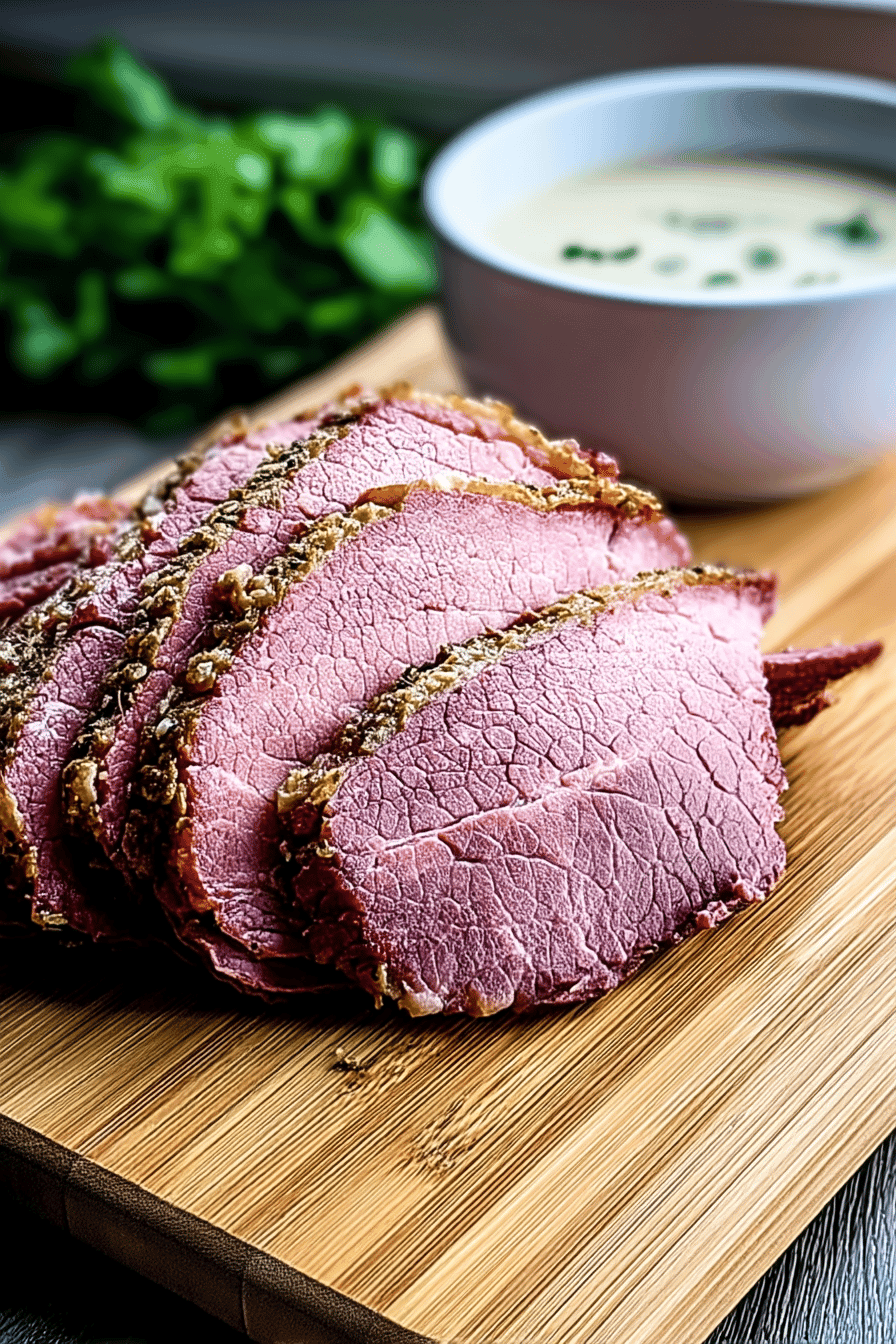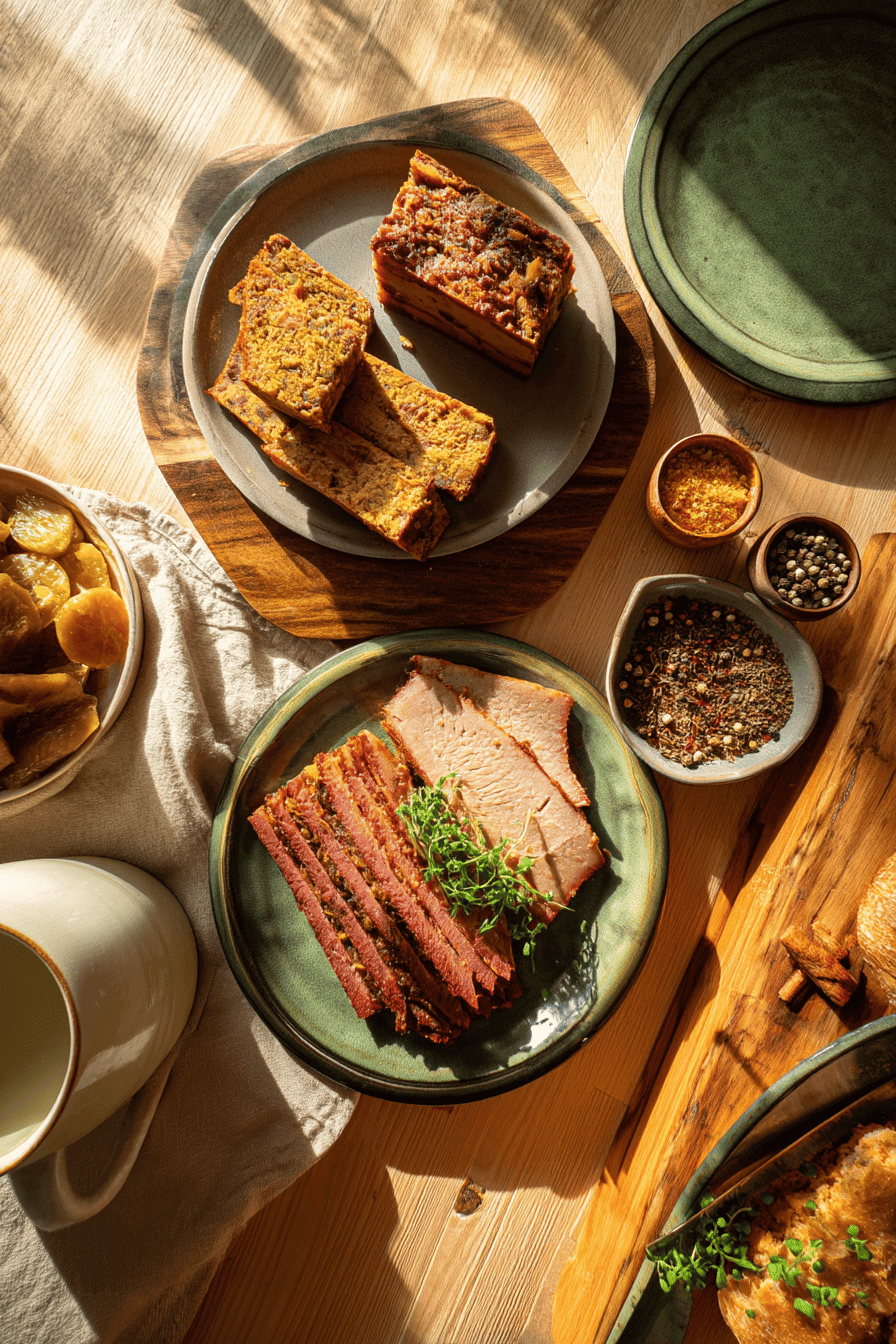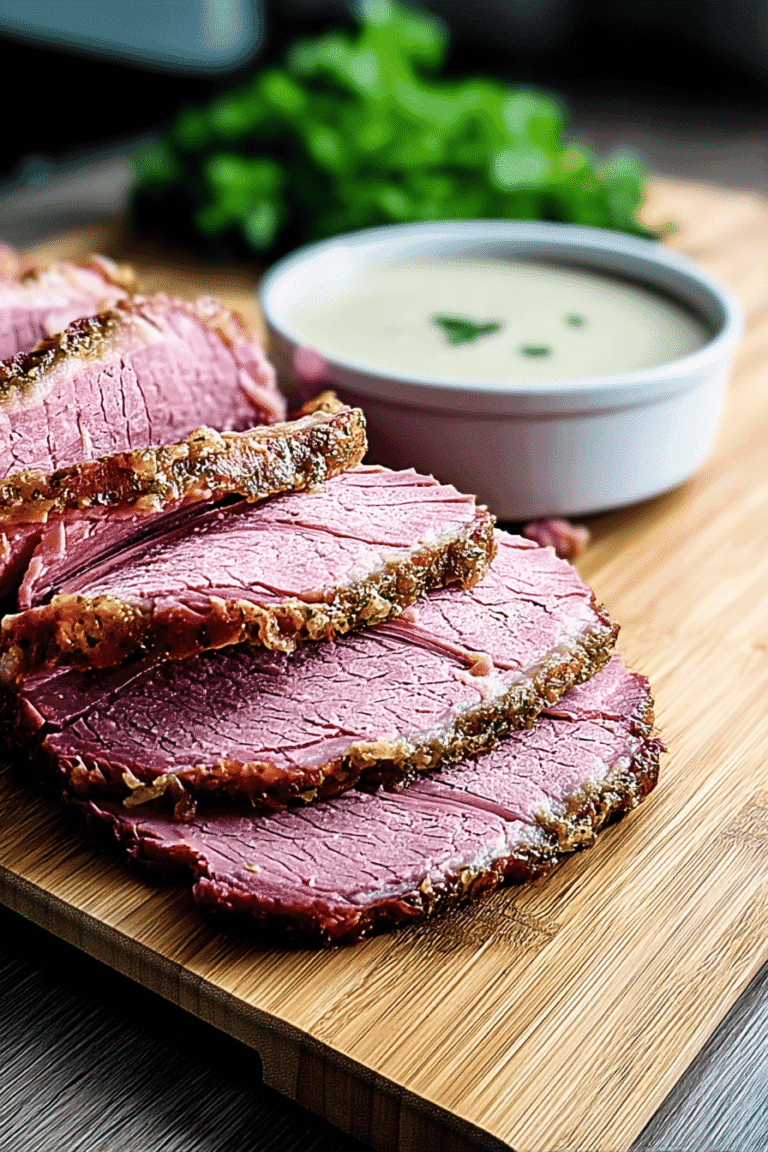Benefits and Advantages of Corned Beef
Corned beef is a versatile and beloved dish known for its straightforward preparation and rich flavor. This recipe suits both home cooks and beginners as it requires minimal ingredients and simple slow-cooking methods to produce tender, flavorful meat. It is rich in protein, supporting muscle growth and repair, making it a nourishing choice for a balanced diet. The slow curing and simmering tenderize the brisket, enhancing texture and taste without complicated techniques.
The unique flavor of corned beef comes from the curing spices such as coriander seeds, black peppercorns, mustard seeds, garlic, and cloves, which create a savory and aromatic profile. The dish can easily be adapted to different dietary lifestyles by replacing key ingredients, thus appealing to diverse palates. Its combination of satisfying flavor and health benefits positions corned beef as a practical and hearty meal for everyday cooking. Related terms such as cured beef and salt beef are useful for clear communication and SEO optimization.
Jump to:
- Benefits and Advantages of Corned Beef
- Essential Ingredients for Corned Beef
- Dietary Substitutions to Customize Your Corned Beef
- Vegan Options
- Gluten-Free Adaptations
- Low-Sodium Variations
- Lean Protein Substitutes
- How to Prepare the Perfect Corned Beef: Step-by-Step Guide
- Mastering Corned Beef: Advanced Tips and Variations
- How to Store Corned Beef: Best Practices
- Nutritional Value of Corned Beef
- FAQs: Frequently Asked Questions About Corned Beef
- What exactly is corned beef and how is it made?
- How long should I brine corned beef at home, and should it be refrigerated?
- Can I cook vegetables like cabbage with corned beef, and how should I do it?
- Is it safe to skip curing salt when making corned beef at home?
- How can leftover corned beef be stored and reheated safely?
- Corned Beef Recipe: How to Make Tender Homemade Braised Brisket
- Ingredients
- Instructions
- Last Step:
- Notes
- Nutrition
- Did you make this recipe?
Essential Ingredients for Corned Beef
This corned beef recipe requires the following ingredients:
- 3 pounds of corned beef brisket, including the spice packet provided
- 2 cups coarse kosher salt
- ½ cup sugar
- 5 smashed garlic cloves
- 5 tablespoons pickling spices (commonly coriander seeds, black peppercorns, mustard seeds, bay leaves, cloves)
- 1 tablespoon plus 1 teaspoon pink curing salt (sodium nitrite)
- About 4 to 5 pounds beef brisket (1.8 to 2.3 kg)
- 4 cups water for simmering
- 1 large chopped onion
- Whole peppercorns for seasoning
- 2 bottles of beer and 2 bottles of ginger beer for cooking (about 24-32 oz / 710-946 ml each)
- Optional: quartered cabbage, peeled carrots, potatoes, and turnips for traditional boiled dinner additions
For vegans or diet-restricted individuals, it’s possible to substitute plant-based proteins like tempeh or seitan, and use low-calorie vegetable broth in place of water for lighter alternatives. Each ingredient plays a critical role: kosher and curing salts preserve and color the meat, sugar balances saltiness, and pickling spice delivers characteristic flavor complexity.

Dietary Substitutions to Customize Your Corned Beef
To tailor this corned beef recipe to various dietary needs or ingredient availability, consider the following substitutions:
Vegan Options
- Use jackfruit, lentils, or seitan to replicate the texture and spice of corned beef when cooked with traditional curing spices.
Gluten-Free Adaptations
- Ensure all spices and broths are certified gluten-free. Avoid spice blends with gluten-containing fillers.
Low-Sodium Variations
- Rinse the corned beef well before cooking to reduce salt, use low-sodium seasoning blends or broths.
Lean Protein Substitutes
- Choose leaner beef cuts or substitute with turkey breast to reduce fat and calories while maintaining flavor.
These substitutions keep the dish flavorful and accessible. Using related terms like brined beef or salt-cured meat throughout supports SEO and natural readability.

How to Prepare the Perfect Corned Beef: Step-by-Step Guide
- Rinse the beef: Thoroughly rinse the corned beef under cold water to remove excess salt, ideal for balanced seasoning and sodium control.
- Prepare pot and liquid: Place beef brisket in a large pot, cover with water or low-sodium vegetable broth.
- Add seasoning: Include the spice packet supplied with the brisket, chopped onion, smashed garlic cloves, and whole peppercorns.
- Bring to boil and simmer: Heat until boiling, then reduce to a gentle simmer. Cover the pot to maintain moisture and tenderness.
- Slow cook: Allow the beef to simmer for about 3 hours until fork-tender and easy to slice or shred.
- Vegan option: Substitute plant-based proteins like tempeh, cooking similarly in the seasoned liquid.
- Rest meat: Remove from cooking liquid and let rest before slicing against the grain for maximum tenderness.
- Serve: Pair with traditional cabbage, carrots, potatoes, or customize sides to meet dietary requirements.
Following this straightforward method guarantees tender, flavorful corned beef suited for a variety of diets. For more detailed techniques, consider referencing corned beef curing process and how to cook tender corned beef.
Mastering Corned Beef: Advanced Tips and Variations
Take your corned beef preparation to the next level by incorporating these expert tips and creative variations. Marinating the beef overnight in the seasoned brine enhances both flavor and tenderness, allowing the spices to penetrate deeply.
Try adding spices like star anise, mustard seeds, or cloves to your pickling spice mix for a richer aromatic profile. For a smoky finish, after cooking, grill or broil the corned beef briefly to add a crispy crust. Including vegetables such as cabbage, carrots, and potatoes during the last hour of simmering creates a complete one-pot meal that embodies the traditional Irish boiled dinner experience.
For dietary adaptations, alternative proteins like seitan or jackfruit can mimic the texture while keeping the dish vegan. To cater to low-sodium preferences, rinse the brisket before cooking and use reduced-salt spice blends. These small changes allow flexibility while preserving the iconic flavors of this classic dish.
How to Store Corned Beef: Best Practices
Proper storage extends the freshness and quality of corned beef. After cooking, allow the meat to cool to room temperature before sealing it tightly in an airtight container. Refrigerate for 3 to 5 days to maintain optimal flavor and safety.
For longer-term storage, freeze the corned beef wrapped in plastic wrap and then aluminum foil or in a freezer-safe bag to minimize freezer burn. Frozen corned beef can remain good for up to 2 months.
When reheating, gently warm the meat using a microwave on low power or on the stovetop with a small amount of broth to retain moisture and tenderness, avoiding overcooking that may dry out the meat.
Nutritional Value of Corned Beef
| Nutrient | Amount per 3-ounce Serving | Notes |
|---|---|---|
| Calories | 210 kcal | Energy content varies by cut and cooking method |
| Protein | 17 grams | High-quality protein for muscle repair |
| Total Fat | 15 grams | Includes approximately 6 grams saturated fat |
| Sodium | High | From curing salts; monitor portion sizes |
| Iron | Significant | Supports oxygen transport in the blood |
| Vitamins B12 and B6 | Present | Contribute to nerve health and energy metabolism |
This nutritional profile demonstrates that corned beef is nutrient-rich but also high in sodium, highlighting the importance of moderation or sodium-reduction strategies in preparation. For further nutritional insights, see this nutritional content of corned beef.

FAQs: Frequently Asked Questions About Corned Beef
What exactly is corned beef and how is it made?
How long should I brine corned beef at home, and should it be refrigerated?
Can I cook vegetables like cabbage with corned beef, and how should I do it?
Is it safe to skip curing salt when making corned beef at home?
How can leftover corned beef be stored and reheated safely?

Corned Beef Recipe: How to Make Tender Homemade Braised Brisket
🥩 Discover the richness of homemade corned beef with this recipe, ensuring tender, flavorful brisket every time.
🌿 Embrace the traditional Irish touch with your own cured brisket that’s perfect for family gatherings or special meals.
- Total Time: 5 to 7 days plus 3.5 hours
- Yield: 8 servings 1x
Ingredients
2 cups coarse kosher salt
½ cup sugar
5 smashed garlic cloves
5 tablespoons pickling spices
1 tablespoon plus 1 teaspoon pink curing salt (sodium nitrite)
4– to 5-pound (1.8 to 2.3 kg) beef brisket
2 bottles of beer
2 bottles of ginger beer
Instructions
1. Heat about a gallon (3.8 liters) of water with kosher salt, sugar, garlic, 3 tablespoons pickling spices, and pink curing salt until dissolved.
2. Cool the brine in the refrigerator.
3. Submerge the brisket in the cooled brine, weight it down, cover, and refrigerate for 5 to 7 days, turning the meat daily.
4. After curing, rinse the brisket under cool water to remove excess salt.
5. Place the brisket in a pot, cover with beer and ginger beer, and add remaining pickling spices.
6. Bring to a boil, then cover and simmer gently for about 3 hours until tender. Add more water if needed.
7. Optional: Add quartered cabbage and peeled carrots during the last hour of cooking.
8. Slice the corned beef thinly to serve alongside root vegetables or use in sandwiches.
Last Step:
Please leave a rating and comment letting us know how you liked this recipe! This helps our business to thrive and continue providing free, high-quality recipes for you.Notes
💡 Do not skip the curing salt as it ensures the classic color and flavor.
🥕 Keeping the brine refrigerated is crucial for safety and effective curing.
🍽️ Cook slowly for tender meat; a slow cooker can help maintain low temperatures.
- Prep Time: 30 minutes
- Curing Time: 5 to 7 days
- Cook Time: 3 hours
- Category: Main Course
- Method: Braised
- Cuisine: Irish
- Diet: Non-Vegetarian
Nutrition
- Serving Size: 1 slice
- Calories: 285
- Sugar: 5g
- Sodium: 950mg
- Fat: 20g
- Saturated Fat: 7g
- Unsaturated Fat: 10g
- Trans Fat: 1g
- Carbohydrates: 8g
- Fiber: 0g
- Protein: 18g
- Cholesterol: 75mg







